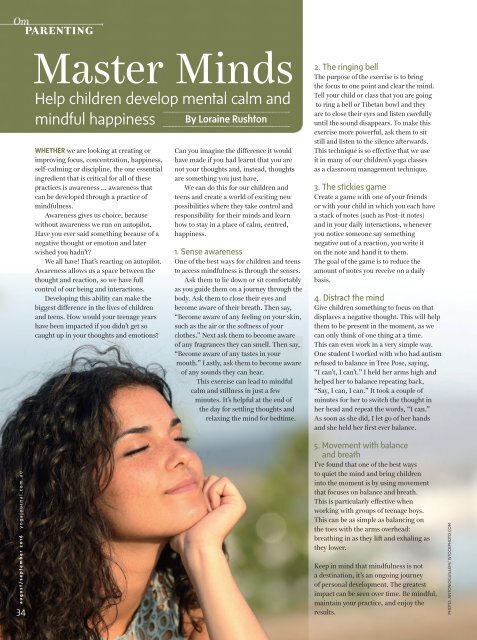Australian_Yoga_Journal_2016_08_09_downmagaz.com
Create successful ePaper yourself
Turn your PDF publications into a flip-book with our unique Google optimized e-Paper software.
Om<br />
PARENTING<br />
Master Minds<br />
Help children develop mental calm and<br />
mindful happiness<br />
WHETHER we are looking at creating or<br />
improving focus, concentration, happiness,<br />
self-calming or discipline, the one essential<br />
ingredient that is critical for all of these<br />
practices is awareness … awareness that<br />
can be developed through a practice of<br />
mindfulness.<br />
Awareness gives us choice, because<br />
without awareness we run on autopilot.<br />
Have you ever said something because of a<br />
negative thought or emotion and later<br />
wished you hadn’t?<br />
We all have! That’s reacting on autopilot.<br />
Awareness allows us a space between the<br />
thought and reaction, so we have full<br />
control of our being and interactions.<br />
Developing this ability can make the<br />
biggest difference in the lives of children<br />
and teens. How would your teenage years<br />
have been impacted if you didn’t get so<br />
caught up in your thoughts and emotions?<br />
By Loraine Rushton<br />
Can you imagine the difference it would<br />
have made if you had learnt that you are<br />
not your thoughts and, instead, thoughts<br />
are something you just have.<br />
We can do this for our children and<br />
teens and create a world of exciting new<br />
possibilities where they take control and<br />
responsibility for their minds and learn<br />
how to stay in a place of calm, centred,<br />
happiness.<br />
1. Sense awareness<br />
One of the best ways for children and teens<br />
to access mindfulness is through the senses.<br />
Ask them to lie down or sit <strong>com</strong>fortably<br />
as you guide them on a journey through the<br />
body. Ask them to close their eyes and<br />
be<strong>com</strong>e aware of their breath. Then say,<br />
“Be<strong>com</strong>e aware of any feeling on your skin,<br />
such as the air or the softness of your<br />
clothes.” Next ask them to be<strong>com</strong>e aware<br />
of any fragrances they can smell. Then say,<br />
“Be<strong>com</strong>e aware of any tastes in your<br />
mouth.” Lastly, ask them to be<strong>com</strong>e aware<br />
of any sounds they can hear.<br />
This exercise can lead to mindful<br />
calm and stillness in just a few<br />
minutes. It’s helpful at the end of<br />
the day for settling thoughts and<br />
relaxing the mind for bedtime.<br />
2. The ringing bell<br />
The purpose of the exercise is to bring<br />
the focus to one point and clear the mind.<br />
Tell your child or class that you are going<br />
to ring a bell or Tibetan bowl and they<br />
are to close their eyes and listen carefully<br />
until the sound disappears. To make this<br />
exercise more powerful, ask them to sit<br />
still and listen to the silence afterwards.<br />
This technique is so effective that we use<br />
it in many of our children’s yoga classes<br />
as a classroom management technique.<br />
3. The stickies game<br />
Create a game with one of your friends<br />
or with your child in which you each have<br />
a stack of notes (such as Post-it notes)<br />
and in your daily interactions, whenever<br />
you notice someone say something<br />
negative out of a reaction, you write it<br />
on the note and hand it to them.<br />
The goal of the game is to reduce the<br />
amount of notes you receive on a daily<br />
basis.<br />
4. Distract the mind<br />
Give children something to focus on that<br />
displaces a negative thought. This will help<br />
them to be present in the moment, as we<br />
can only think of one thing at a time.<br />
This can even work in a very simple way.<br />
One student I worked with who had autism<br />
refused to balance in Tree Pose, saying,<br />
“I can’t, I can’t.” I held her arms high and<br />
helped her to balance repeating back,<br />
“Say, I can, I can.” It took a couple of<br />
minutes for her to switch the thought in<br />
her head and repeat the words, “I can.”<br />
As soon as she did, I let go of her hands<br />
and she held her first ever balance.<br />
august/september <strong>2016</strong> yogajournal.<strong>com</strong>.au<br />
34<br />
5. Movement with balance<br />
and breath<br />
I’ve found that one of the best ways<br />
to quiet the mind and bring children<br />
into the moment is by using movement<br />
that focuses on balance and breath.<br />
This is particularly effective when<br />
working with groups of teenage boys.<br />
This can be as simple as balancing on<br />
the toes with the arms overhead:<br />
breathing in as they lift and exhaling as<br />
they lower.<br />
Keep in mind that mindfulness is not<br />
a destination, it’s an ongoing journey<br />
of personal development. The greatest<br />
impact can be seen over time. Be mindful,<br />
maintain your practice, and enjoy the<br />
results.<br />
PHOTO: ANTONIOGUILLEM/ ISTOCKPHOTO.COM


